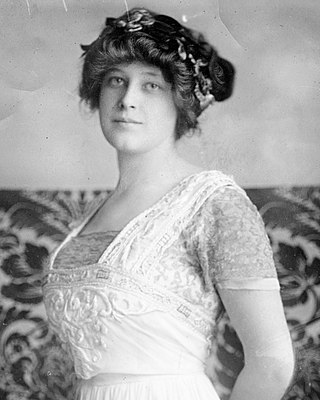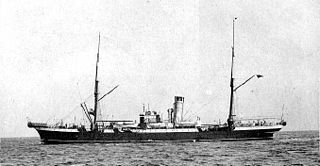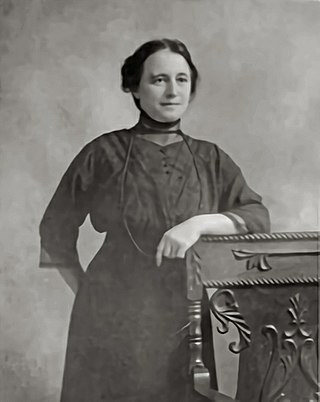
Benjamin Guggenheim was an American businessman, who was a wealthy member of the Guggenheim family. He was among the most prominent American passengers aboard RMS Titanic and perished along with 1,500 people when the ship sank on her maiden voyage.

Madeleine Talmage Dick was an American socialite and a survivor of the RMS Titanic. She was the second wife and widow of businessman John Jacob Astor IV.

The Cable Ship Mackay-Bennett was a transatlantic cable-laying and cable-repair ship registered at Lloyd's of London as a Glasgow vessel but owned by the American Commercial Cable Company. She is notable for being the ship that recovered the majority of the bodies after the sinking of the Titanic.

Barbara Joyce Dainton was the penultimate remaining survivor of the sinking of the RMS Titanic on 14 April 1912 after hitting an iceberg on its maiden voyage. She was the last living survivor who travelled second-class on the ship.

Edith Haisman was a South African-British woman who was one of the last remaining and oldest survivors of the sinking of RMS Titanic in April 1912. She was the last survivor born in the 19th century, and therefore the last survivor who was a teenager at the time of the sinking, although seven younger survivors outlived her.

RMS Titanic sank on 15 April 1912 in the North Atlantic Ocean. The largest ocean liner in service at the time, Titanic was four days into her maiden voyage from Southampton to New York City, with an estimated 2,224 people on board when she struck an iceberg at 23:40 on 14 April. Her sinking two hours and forty minutes later at 02:20 ship's time on 15 April, resulted in the deaths of more than 1,500 people, making it one of the deadliest peacetime maritime disasters in history.

Robert Williams Daniel was an American banker who survived the sinking of the RMS Titanic in 1912, and later became a gentleman farmer and served in the Virginia Senate.
A total of 2,240 people sailed on the maiden voyage of the Titanic, the second of the White Star Line's Olympic-class ocean liners, from Southampton, England, to New York City. Partway through the voyage, the ship struck an iceberg and sank in the early morning of 15 April 1912, resulting in the deaths of 1,517 passengers and crew.
Henry Sleeper Harper was an American businessman. He was an incorporator of Harper & Brothers when the firm became a corporation in 1896. Harper is remembered as a passenger on the RMS Titanic when it sank on April 15, 1912, particularly because his Pekingese called Sun Yat-sen was one of three dogs to survive the sinking of the Titanic, and also for his work to save the Adirondack forests from logging.

Louise Gretchen Kink Pope, or Louise Kink, was a Swiss-American woman who was one of the last remaining survivors of the sinking of RMS Titanic on April 15, 1912.

The ship's cat has been a common feature on many trading, exploration, and naval ships dating to ancient times. Cats have been brought on ships for many reasons, most importantly to control rodents. Vermin aboard a ship can cause damage to ropes, woodwork, and more recently, electrical wiring. In addition, rodents threaten ships' stores, devour crews' foodstuff, and can cause economic damage to ships' cargo, such as grain. Vermin are also a source of disease, which is dangerous for ships that are at sea for long periods of time. Rat fleas are carriers of plague, and rats on ships were believed to be a primary vector of the Black Death.

Titanic Lifeboat No. 1 was a lifeboat from the steamship Titanic. It was the fifth boat launched to sea, over an hour after the liner collided with an iceberg and began sinking on 14 April 1912. With a capacity of 40 people, it was launched with only 12 aboard, the fewest to escape in any one boat that night.
Margaret Bechstein Hays was a passenger on the RMS Titanic. She and her dog survived the ship's sinking, escaping on lifeboat no. 7. Following the disaster, she cared for two small children known as the "Titanic Orphans" in her New York City home until their mother claimed them.

Lifeboats played a crucial role during the sinking of the Titanic on 14–15 April 1912. The ship had 20 lifeboats that, in total, could accommodate 1,178 people, a little over half of the 2,209 on board the night it sank.

Rhoda Mary Abbott was a passenger on the RMS Titanic. She was the only female passenger who went down with the sinking of the ship and survived.

Pet travel is the process of traveling with or transporting pets. Pet carriers like cat carriers and dog crates confine and protect pets during travel.
Rigel, supposedly, was a large black Newfoundland dog who was said to have saved some of the survivors of the sinking of the RMS Titanic. One account of the story was published in the New York Herald, April 21, 1912, the other was the book Sinking of the Titanic and Great sea disasters by Logan Marshall, published in 1912.

Edith Louise Rosenbaum Russell was an American fashion buyer, stylist and correspondent for Women's Wear Daily, best remembered for surviving the 1912 sinking of the RMS Titanic with a music box in the shape of a pig. The papier-mâché toy, covered in pigskin and playing a tune known as "The Maxixe" when its tail was twisted, was used by Edith Russell to calm frightened children in the lifeboat in which she escaped. Her story became widely known in the press at the time and was later included in the best-selling account of the disaster A Night to Remember by Walter Lord. Russell was also portrayed in the award-winning British film produced by William MacQuitty that was based on Lord's book.

Frederick William Barrett was a British stoker. After having served as a stoker on several ships, on 6 April 1912, he was hired on board the RMS Titanic as lead stoker. On April 15, 1912, while the ship was sinking, Barrett boarded lifeboat No. 13 and took command of it, thus surviving the disaster. He later testified before commissions of inquiry into the sinking of the ship and continued to work in the navy until the 1920s. In 1923, after losing his wife Mary Anne Jones, he remained in Liverpool and worked ashore as a logger.
Jane Quick was a British-American woman who was a survivor of the sinking of the RMS Titanic on 15 April 1912.
















